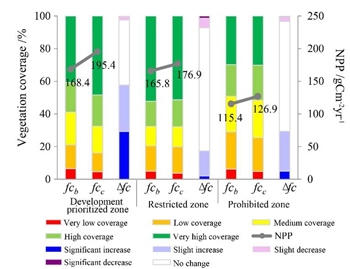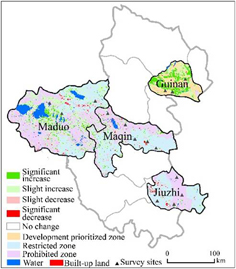Researchers Assess the Effects of Restoration Approaches in Key Ecological Function Zones in the Headwater Areas of the Yellow River
The evaluation of ecological technology based on major function-oriented zones (MFOZs) can provide a scientific basis for carrying out ecological governance and for proposing a coordinated development scheme for the ecological industry.
Prof. ZHEN Lin’s team at the Institute of Geographic Sciences and Natural Resources Research of the Chinese Academy of Sciences proposed effective approaches for restoration, and found evidence of alpine grassland restoration and sustainable regional development. The team’s research has been published in the Journal of Resources and Ecology.
Given the great extent of alpine grassland coverage and intensive animal grazing activity, the ecosystem and the livelihoods of herders are extremely vulnerable in the headwater areas of the Yellow River. A series of studies have been undertaken to develop measures to restore degraded grasslands in this region of China.
The team evaluated the effects of restoration approaches in three MFOZs. The zones either prioritized, restricted, or prohibited development, had different environmental carrying capacities, and differed in the intensity of grassland utilization.
The study showed that the grassland recovery rate was higher in the development prioritized zone than in the restricted or prohibited zones during 2000 and 2016. Higher coverage of grasslands increased in those areas of the prioritized zone where crop-forage cultivation and grass seeding dominated (Fig. 1).
 |
 |
| (a) Vegetation coverage and NPP in different zones | (b) Spatial differences in vegetation coverage |
|
Fig.1 Vegetation fraction coverage and NPP in different MFOZs (Image by ZHEN Lin’s team) | |
The results of the study indicated that the net incomes of households in the development prioritized zone were the highest of all three zones. The researchers found that herders in the development prioritized zone had greater awareness and were more willing to restore grassland than herders in the restricted zone. In this zone, more herders adopted approaches that combined enclosures, rodent control, crop-forage cultivation and warm sheds.
The project was supported by the National Key Research and Development Program of China, and was called “Methodology and Indicator System for Assessing Ecological Restoration Technology and Evaluation of Global Ecosystem Rehabilitation Approaches (2016-2020)”.
Reference:
WEI Yunjie, ZHEN Lin, DU Bingzhen. 2020, Effects of Grassland Restoration Approaches in Different Major Function-oriented Zones of the Headwater Region of the Yellow River in China. Journal of Resources and Ecology, 2020,11(2): 150-158.
Download attachments: